The hike making Australia a better place
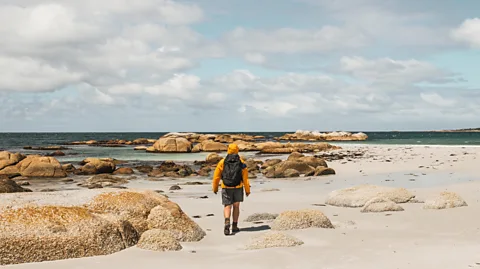 Tayla Gentle
Tayla GentleTasmania's wukalina Walk is much more than a tourism product. It's a vehicle for Aboriginal empowerment, cultural strength and reconnection – and a chance for visitors to learn.
"Go and pick a piece of kelp that speaks to you," said Janice, a palawa (Tasmanian Aboriginal) woman and cultural storyteller on our tour. She pointed to a bucket full of thick, blubbery bull kelp we'd collected off the beach that morning to make baskets for carrying water. Meanwhile, Jam, our main guide, reverentially placed leaves and branches from a black peppermint gum tree on the fire embers as he prepared a smoking ceremony to welcome us to Country. Around us, some young Aboriginal men were lounging around the firepit, carving spears out of branches.
Sitting at our camp, deep in the coastal bush of Australia's island-state of lutruwita (Tasmania), I realised I couldn't have asked for a more powerful or authentic introduction to palawa culture – and what was even more surprising is that many people think that the culture doesn't even exist.
I was on the wukalina Walk, a four-day Indigenous-guided walk along Tasmania's north-east coast that every visitor to Australia – and likely every Australian – should experience. Although the hike is along one Australia's most beautiful stretches of coastlines, wukalina Walk is much more than a tourism product with magnificent scenery. This utterly unique hike operates on a deeper level, taking visitors into the island's darkest history.
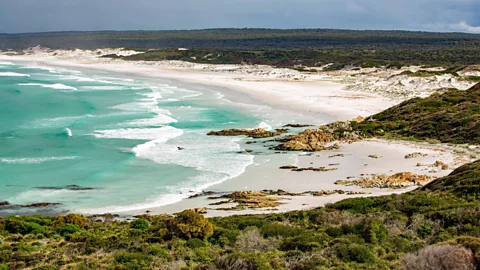 Jillian Mundy
Jillian MundyTasmania was the site of some of the most brutal conflicts in the country. The British arrived in 1803, setting up a penal colony on the island and decimating the palawa population through disease, dispossession and violence. The colonisers forced the remaining Tasmanian Aboriginals onto missions, where most died, and rounded others up onto a reserve on Cape Barron Island, one of the Furneaux Islands just off Tasmania's north-east coast.
Reclaiming a language
Not only was their population decimated due to the devastating effects of colonisation, but palawa languages were also outlawed. However, over the last 30 years, it has been arduously rebuilt and revived by the palawa community with the help of linguistic experts. Today, the burgeoning language palawa kani (which means "Tasmanian Aborigines speak") is increasingly being used and taught by the community. Find out more here.
Until recently, it was taught in schools throughout Australia that there were no Aboriginal people left in Tasmania – that the last one, Trukanini, had died in 1876. But the truth is that the palawa people survived the cultural genocide and have had a continuous link to this stretch of coastline for tens of thousands of years, even if the government only officially recognised Aboriginal people as Tasmania's First People in 1996.
"One thing we're really good at on this walk is dispelling myths," Jam said. "One of the myths is that we don't exist. But it's very obvious when you come on an Aboriginal walk, being guided by Aboriginal people, that you're tapping into that culture."
It was hard to fathom this brutal history when we'd started our hike the previous day at the eponymous wukalina, the palawa name for Mount William, a hill that seemed higher than its humble 216m in this flat land. As our group of six hikers ascended, we walked past kunzea bushes, fragrant with cottonwool-like flowers, and black peppermint gums swaying in the breeze. Soft sponges of creamy coral lichen bordered the track.
 Jillian Mundy
Jillian MundyWukalina is a place of immense importance to palawa, and Jam gently wove stories into the landscape as we walked, telling tales passed down from his Elders. It was one thing to walk under the massive black peppermint gums, but another to learn that these trees were central to the palawa kinship system and funerary practices; or that they were so-named by the British colonisers for the black fire scars on their trunks, a result of the cultural burning that palawa used to sustainably manage the land.
"The walk is grounded in authenticity and culture as our bloodlines extend so deep through this place," said Jam. "Up here as north-eastern people, [these trees] are our family; they link us to the afterlife."
When we reached the summit, scrambling over protruding tree roots and giant granite rocks, we could just make out the dusty blue hills of Cape Barren Island, or truwana as it's called in palawa kani, in the distance.
"Truwana has been a stronghold of our culture for quite a few generations," said Jam, explaining that not only was the reserve located on truwana, but many Aboriginal women, who were master seal hunters, were taken as slaves and put to work on the islands catching seals. Aboriginal resistance fighters would light fires on this summit to send messages to them, he said, burning the kunzea shrubs we'd walked past and using smoke signals to let the women know if the colonisers were sailing back up the coast from Hobart. "For a while it was the only communication they had with their people," he added.
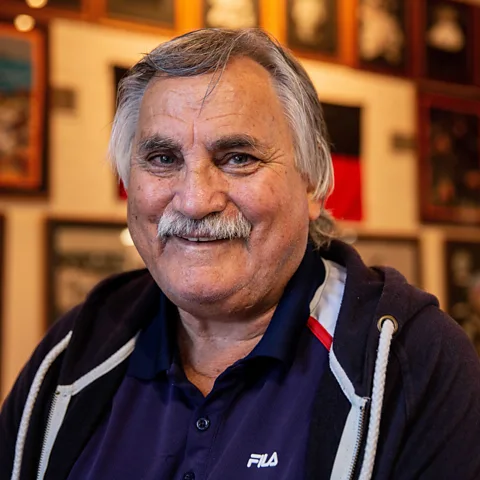 Jillian Mundy
Jillian MundyToday, Cape Barren and the other Furneaux Islands are a hub for muttonbirding, an important cultural practice for Tasmanian Aboriginal people that involves the harvesting of short-tailed shearwater chicks for food, oil and feathers every March/April. Jam was there last year, he told us, longingly, and another of wukalina's main guides, Carleeta, was muttonbirding on Cape Barren right now.
And this is exactly why the walk takes place here, on Tasmania's north-east coast. Walking alongside Aboriginal guides through their cultural heartland, with Cape Barren Island shimmering on the horizon, makes it clear – beyond anything you could read – that this is a living culture that resisted and survived. And that's probably the most important thing about wukalina Walk: although history is an integral part of the experience, it's as much about the lives of palawa today.
While the walk has been operating for five years – and in that time has won a swathe of awards, including winning gold at the 2022 Australian Tourism Awards – the project was 15 years in the making. In fact, it only exists due to the vision of Clyde Mansell, a palawa Elder and the former chairman of the Tasmanian Aboriginal Land Council, who had the idea of a tourism product that would empower, reconnect and strengthen Tasmania's Aboriginal community. Having been involved in Aboriginal land rights since the 1970s, it would be a chance, he thought, for palawa to share their story in the right way and in the right place.
"It's about telling our story the way we want it told," he said, noting that wukalina is the first tourism product in Australia to be designed, owned and guided by the Aboriginal community. "I always felt that if we could develop something where we could take people on Country, then the interpretation would be much easier."
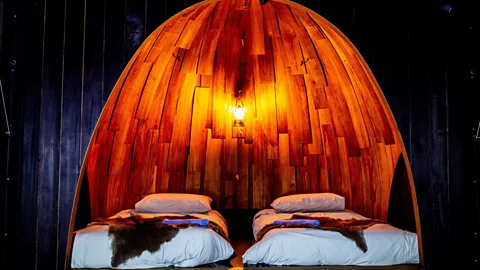 Jillian Mundy
Jillian MundyMansell was especially keen to get the next generation of Aboriginal people involved to ensure that cultural knowledge would be passed on. "I wanted the younger people to tell those stories," he said.
That was something I was honoured to see first-hand. After descending wukalina, we trekked through endless bush, guided by the sound of the ocean. We brushed past elegant grass trees and over hardy tussocks of button grass, stopping to admire pops of colour in scarlet common heath flowers, yellow-coned banksias and tiny red carnivorous sundews. After several hours of walking, our camp for the next two nights, krakani lumi (meaning "place of rest"), was a welcome sight.
Here, we were met by several young Aboriginal men who had come for training, to both learn the ropes of running a tourism project – that night preparing a feast of scallops and damper, muttonbird and potato salad – but also to listen to the traditional stories and learn how to safely share cultural knowledge. Watching the more experienced guides like Jam, who has been guiding at wukalina for three years, give advice on the best way to throw a spear or summoning one of the lads over to listen as he told yarns around the fire, were among the trip's most powerful moments.
They're still powerful moments for Jam too, despite having led hundreds of walks. When I asked him what he's proudest of, he said: "I think it's seeing the young fellas step in and stand up a bit straighter and puff their chest out a bit stronger."
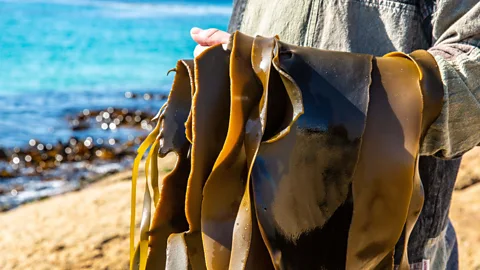 Jillian Mundy
Jillian MundyJam explained that while some stay on as guides at wukalina, others use that cultural knowledge to move into Aboriginal divisions within the National Parks System or into Tasmanian Aboriginal Heritage Officer training. "We'll see a lot of them step out into other areas and be more proud and more strong," he said. "That's a really powerful part of our community: we're all trying to benefit and uplift each other and share knowledge and skills. And that really comes from surviving genocide."
Day two of the tour is a rest day, and for us it started with an impromptu yoga class led by Travis, one of the trainees, who pulled out hilarious made-up poses like the one-legged emu and the flapping muttonbird. Around us at the architecturally designed camp – a modern representation of the domed structures that palawa used to live in – other young men were launching their newly carved spears into the grass trees and discussing throwing techniques. It was also the day of the smoking ceremony and kelp basket making, but a highlight was the short meander along the beach to a "cultural living site" behind a sand dune – a gathering place where Aboriginal groups would have congregated over many thousands of years, leaving behind shells and bones as evidence of their presence.
"Please don't call it a midden," Jam said, referring to the term often used to describe these sites. "That's a Gaelic word for a rubbish dump."
The energy here was palpable, and we were all quiet as we carefully explored. "Actually being on Country and hearing the stories on Country where they originated is really beautiful," Laura Walker, who had travelled from New South Wales with her husband for the walk, later told me. "You can read all the books in the world, but experiencing it makes such a big difference."
 Ellie Cobb
Ellie CobbThe third day of wukalina involves walking 17km along the beach, past granite headlands smothered in orange lichen, along deserted white-sand beaches framed by crashing ocean waves and towards the lighthouse that marks Tasmania's most easterly point: Larapuna, or Eddystone Point. This piece of land was returned to the palawa community in 2006 due to its cultural significance – though only on a 40-year lease. Wind bellowed up the beach and an albatross soared effortlessly above the ocean. At one point, Jam led us into the surrounding scrub and pointed out various edible plants and berries. All I could see were bare trees and bushes, but to Jam, this was a veritable smorgasbord.
"One of the best things about the tour is getting a much deeper understanding of how incredibly engaged with the landscape the Aboriginal people here were," said Amelie Hudspeth, another hiker in our group.
In fact, much of the walk is focussed on caring for the land as the Tasmanian Aboriginals have done for tens of thousands of years. During the four-day trip, Jam, who is about to graduate in marine biology and Antarctic ecology from The University of Tasmania, touched on a plethora of related topics, from the biodiversity crisis to Indigenous land management to climate change. From a bluff near the lighthouse, he pointed out the decimated giant kelp forests on Tasmania's eastern coast whose decline has literally changed the shape of the coastline. "We need to shift the way we think globally as a people to be more in tune with the landscape," he said. "And by sharing these stories, we're doing that."
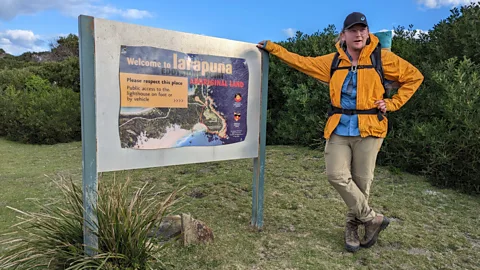 Ellie Cobb
Ellie CobbAs we neared our end point – a 19th-Century lighthouse that was built by convicts on top of another cultural living site – my mind was overflowing with thoughts of a more sustainable way of living; of the brutality of colonisation and the devastation it still wreaks; and of the fortitude of the palawa community that has retained its culture against adversity. And that's exactly where wukalina Walk wants to take you: to a place of education and, ultimately, allyship.
"We try and fit in as much as possible because we see it as a really valuable method of connection, " Jam said. "That being said, we are trying to fit 50,000 years of history in, so we can't cover it all."
"[The walk] is the start of your journey, it's not the end," he added. "We want you to take in as much as you can, but then go forth and keep connecting and learning."
Thoughtful Travel is a BBC Travel series that helps people explore places responsibly and sustainably, all while making them better through regenerative and responsible travel.
---
Join more than three million BBC Travel fans by liking us on Facebook, or follow us on Twitter and Instagram.
If you liked this story, sign up for the weekly bbc.com features newsletter called "The Essential List". A handpicked selection of stories from BBC Future, Culture, Worklife and Travel, delivered to your inbox every Friday.
